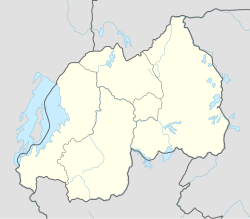Rubengera
Rubengera | |
|---|---|
Sector and town | |
| Coordinates: 2°03′07″S 29°24′52″E / 2.051923°S 29.414434°E | |
| Country | Rwanda |
| Province | Western |
| District | Karongi |
| Area | |
| • Sector and town | 47 km2 (18 sq mi) |
| Population (2022 census)[1] | |
| • Sector and town | 40,337 |
| • Density | 860/km2 (2,200/sq mi) |
| • Urban | 10,431 |
| (2012 census) | |
| Climate | Aw |
Rubengera, also known as Mabanza, is a sector and town in Rwanda. The town is the capital of Karongi District in Western Province, Rwanda.
Rubengera lies in the western mountains of Rwanda between Lake Kivu and the divide that separates the catchments of the Congo River to the west and the Nile. Around 1880 King
A Protestant mission was established at Rubengera in 1909.[4] In World War I was Rubengera a German prisoner-of-war camp for captured Belgian soldiers, military hospital for German soldiers and headquarters of the Commander in Chief of the German troops in Rwanda, Max Wintgens.[5] In 1938 a track was opened that connected Rubengera to Kabgayi to the east. This is the basis for the main road that today connects the region to the east.[6] During the
In July 2012 it was announced that the Rubengera Technical Secondary School would open in January 2013, giving training in carpentry and wood technology. The private school was launched by the Protestant "Abaja ba Kristo" sisterhood.[9]
Notable people
- Consolee Nishimwe - author, speaker, and survivor of the Rwandan genocide
References
Citations
- ^ Citypopulation.de Population of Rubengera sector
- ^ Kimonyo 2008, p. 355.
- ^ Pottier 1986, p. 222-224.
- ^ de Lame 2005, p. 67.
- ^ Innocent Kabagema. Ruanda unter deutscher Kolonialherrschaft 1899-1916. Frankfurt am Main, Germany: Europäischer Verlag der Wissenschaften. 1993, p. 298
- ^ de Lame 2005, p. 72.
- ^ Morel 2010, p. 961.
- ^ Verwimp 2004, p. 237.
- ^ Rubengera Gets New Technical Secondary School.
Sources
- de Lame, Danielle (2005). A Hill Among a Thousand: Transformations And Ruptures in Rural Rwanda. Univ of Wisconsin Press. p. 59. ISBN 978-0-299-21560-6. Retrieved 2013-03-23.
- Kimonyo, Jean-Paul (2008-04-01). Rwanda un génocide populaire. KARTHALA Editions. p. 355. ISBN 978-2-8111-4261-2. Retrieved 2013-03-27.
- Morel, Jacques (June 2010). La France Au Coeur du Génocide des Tutsi. MOREL Jacques. p. 961. ISBN 978-2-84405-242-1. Retrieved 2013-03-27.
- Pottier, Johan P. (April 1986). "The Politics of Famine Prevention: Ecology, Regional Production and Food Complementarity in Western Rwanda". African Affairs. 85 (339). Oxford University Press on behalf of The Royal African Society: 207–237. JSTOR 723013.
- "Rubengera Gets New Technical Secondary School". News of Rwanda. 17 July 2012. Retrieved 2013-03-27.
- Verwimp, Philip (July 2004). "Death and Survival during the 1994 Genocide in Rwanda". Population Studies. 58 (2). Taylor & Francis, Ltd. on behalf of the Population Investigation Committee: 233–245. S2CID 22474530.

